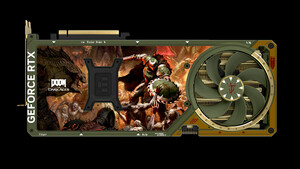nr-Thunder
Commodore
- Registriert
- Sep. 2009
- Beiträge
- 4.547
Sorry, aber selbst die Displayhersteller erklären dir, dass du trotz G-Sync und Freesync V-Sync brauchst.SavageSkull schrieb:Die Erklärung beißt sich aber mit jeder anderen Erklärung von den Sync Funktionen.
https://www.benq.com/en-us/knowledge-center/knowledge/adaptive-sync-tearing.html
Im Gegenteil, der Monitor wartet eben nicht auf das OK, sondern er zeigt den Frame sobald er bei ihm ankommt. Dadurch dass ein 144Hz Monitor aber mit einer Frametime Range von 6,9ms - 33,3ms (bei 30-144 Hz) zurecht kommt, kann er ziemlich viel abbilden. Aber der Monitor kann nicht Zwischenbuffern! Er kann nicht einen Frame der nach 6,8ms kommt in irgend einem RAM zwischenspeichern, und 0,1-0,2 ms später ausgeben. Und G-Sync/Freesync-Monitore können das auch nicht, sie steuern die Bildwiederholungsrate des Monitors, nicht aber den Daten-Input! Ein einzelner unkomprimierter 4k Frame, hätte zwar mit 200Mbps nur 25MB, aber Monitore haben faktisch keinen RAM zum Zwischenspeichern der Frames. Es ist höchstens physisch einer vorhanden um Einstellungen zu speichern. SmartTVs mit kompletten SoCs sind eigene PCs, aber wenn man überlegt wieviel Input-Lag da durch minimale Bildbearbeitung erzeugt wird (Stichwort Gaming-Mode), wären die auch nie in der Lage, einen Frame der 0,1ms zu früh kommt, um 0,1ms zu zögern.SavageSkull schrieb:Bei Gsync/FreeSync, wartet der Monitor auf das OK, das ein Bild im Ausgangsspeicher der Grafikkarte liegt und holt das dann ab. Hier kann jeder Frame auch unterschiedliche Zeit brauchen.
So what happens when just one of those 144 frames renders in, say, 6.8ms (146 FPS average) instead of 6.9ms (144 FPS average) at 144Hz? The affected frame becomes ready too early, and begins to scan itself into the current “scanout” cycle (the process that physically draws each frame, pixel by pixel, left to right, top to bottom on-screen) before the previous frame has a chance to fully display (a.k.a. tearing).
G-SYNC + V-SYNC “Off” allows these instances to occur, even within the G-SYNC range, whereas G-SYNC + V-SYNC “On” (what I call “frametime compensation” in this article) allows the module (with average framerates within the G-SYNC range) to time delivery of the affected frames to the start of the next scanout cycle, which lets the previous frame finish in the existing cycle, and thus prevents tearing in all instances.
And since G-SYNC + V-SYNC “On” only holds onto the affected frames for whatever time it takes the previous frame to complete its display, virtually no input lag is added; the only input lag advantage G-SYNC + V-SYNC “Off” has over G-SYNC + V-SYNC “On” is literally the tearing seen, nothing more.
G-SYNC + V-SYNC “Off” allows these instances to occur, even within the G-SYNC range, whereas G-SYNC + V-SYNC “On” (what I call “frametime compensation” in this article) allows the module (with average framerates within the G-SYNC range) to time delivery of the affected frames to the start of the next scanout cycle, which lets the previous frame finish in the existing cycle, and thus prevents tearing in all instances.
And since G-SYNC + V-SYNC “On” only holds onto the affected frames for whatever time it takes the previous frame to complete its display, virtually no input lag is added; the only input lag advantage G-SYNC + V-SYNC “Off” has over G-SYNC + V-SYNC “On” is literally the tearing seen, nothing more.
Ergänzung ()
Es ist ehrlich gesagt ziemlich ernüchternd, wie so etwas grundlegendes einfach immer noch nicht verstanden wird, und beste Quellen angezweifelt werden (Blur Busters sind eine Bibel der Bildschirmtechnik). Und nachdem in der ersten Seite geradezu BS Antworten gegeben wurden, musste ich auch mit dem Kopf schütteln.Blumentopf1989 schrieb:@Dortmunderjungx ich würde noch ein paar mehr Ausrufezeichen nehmen ;-)
Zuletzt bearbeitet:



